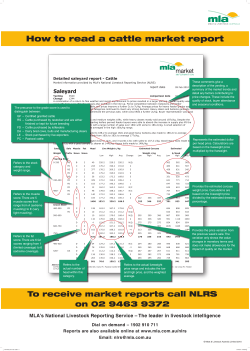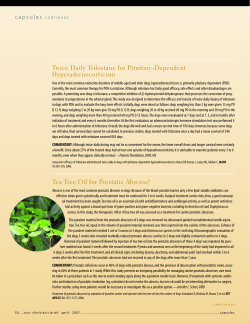
updates from the field News
Newsletter Summer 2013 updates from the field News Parvovirus outbreak The Crookwell district is currently experiencing an outbreak of Parvovirus, a highly infectious disease of dogs. Vaccination is essential to protect pets and working dogs from this potentially fatal disease. Jessica Smith Graduation Jess joined CVH in 2011 while still a high school student, working Saturdays. Her ability, warm personality and dedication to animals led to her current role as a CVH veterinary nurse. We’re very proud to announce Jess has now graduated with a Certificate IV in Veterinary Nursing. Already a highly capable vet nurse, Jess now has an excellent theoretical knowledge base to complement her fantastic hands-on skills. The CVH team thank all our clients for their patronage during 2013 and forward our warm wishes for a special Christmas and New Year. Kittens for adoption CVH is a member of the Mars Petcare Cat Adoption program. We have 9 friendly, socialised and pretty kittens looking for a home. Visit our website (see Services/Cat Adoption Program) to read about the program or call in, spend time with the kittens and talk to our staff about adoption. Parvovirus first appeared as recently as 1978 and has since become one of the most serious diseases affecting dogs worldwide. It is often fatal and mainly (but not always) affects younger animals, particularly puppies and unvaccinated dogs. The death rate in young non-vaccinated puppies can be over 80 per cent. Symptoms and treatment Affected puppies or dogs suddenly become tired, depressed and stop eating. These initial signs rapidly progress to vomiting followed by severe haemorrhagic (bloody) and often foul smelling diarrhoea, dehydration and obvious signs of pain. Early treatment is critical and involves intensive I/V fluid therapy, control of vomiting, pain relief and other supportive treatment. The virus is extremely hardy and can live in the soil for up to 7 years (and for many months on clothing, shoes and floors), making it difficult to control without vaccination. Visit the Animal Care section of our website to read about vaccination schedules. Please phone us on (02) 4832 1977 – we can check your pet’s vaccination status or make an appointment to have your dog vaccinated. Clipping to minimise grass seeds Grass seeds frequently cause persistent and very serious infections in pets and working dogs. Clipping can make a big difference to your dog’s comfort and health during grass seed season. Most grass seeds are designed to burrow into the soil to germinate – and that means they can also penetrate and travel up and into a dog’s ears, nose, eyes, skin and muscle tissues. Let our vet nurses minimise the potential for infection from grass seeds by expertly clipping your dogs. We can provide full clips in tangled long haired dogs to localised clipping of the hair around the ears and eyes, tail, abdomen and between the toes – all prime areas for grass seed infestation. CVH Open Day Crookwell Veterinary Hospital is holding an Open Day on Saturday 22 February 2014. Bring your family and pets and enjoy non-stop activities from 11am to 3pm. We’re planning free pet health checks all day, lucky door prizes and other giveaways, lots of animals big and small to see and pat including Australian Wildlife Displays and a fantastic display of insects from Travel Bugs - and that’s just the start of a fun day! Visit News and Community on our website to see the gallery of images from our 2006 Open Day. Newsletter Summer 2013 updates from the field Pinkeye in cattle Environmental and other predisposing factors Summer conditions – flies, dusty yards and paddocks, harsh ultraviolet light and damage to the eyes from foreign bodies such as thistles and grass seeds – all predispose cattle to pinkeye infection. Younger animals are more vulnerable to infection and genetics also play a role. British and European breeds are more susceptible than Bos indicus cattle, and the white faces of Herefords increase susceptibility. Pinkeye symptoms start with excessive tear production. Without treatment, pinkeye can progress until the eye is severely infected with the potential for loss of sight. Meat and Livestock Australia estimates pinkeye costs Australian beef farmers over $23 million annually in lost production and treatment costs. Pinkeye – infectious bovine kerato-conjunctivitis – is a painful and debilitating disease that left untreated can lead to permanent blindness. The potential impact on the mob – up to 80% infected – makes effective and early treatment of the disease essential. The causative organism, the bacterium Moraxella bovis, produces a toxin that causes severe inflammation on the surface of the eye and in the surrounding tissues. It is highly infectious and spreads rapidly through a herd. Symptoms Affected animals initially have a runny, red and inflamed eye. Increased sensitivity to light causes the animal to blink frequently. One or both eyes can be affected. The classic pinkeye white spot (an ulcer) forms in the centre of the eye. In an attempt to heal the ulcer, blood vessels grow across the cornea. If healing occurs, the eye turns cloudy blue and, after 4 to 5 weeks, returns to normal or retains a white scar. Without early treatment, the initial white spot can turn yellow (indicating an eye chamber full of pus), may rupture and progress to become a shrunken, sightless eye. Cattle with both eyes affected can die from starvation, thirst or misadventure. Pinkeye can persist within a herd through carrier animals. These cattle show no symptoms but if predisposing conditions create excess tear production, flies are attracted. These feed on the infected secretions and spread the bacteria from animal to animal. Minimising infection and spread • Avoid confining cattle in dusty yards for long periods. • Avoid grazing paddocks with heavy infestations of thistles and sharp, dry stubble. • If mustering a mob to treat pink eye, water down dusty yards, or isolate and treat individual animals to avoid spread. • Consider fly control. Applying an animal fly repellent to the head of cattle deters flies for several weeks. Treatment Early treatment is essential and results in faster healing with less scarring. Most importantly, it limits spread by decreasing the infective bacteria in a mob. • The most effective treatment to date is the long-acting (48 hours) penicillin eye ointment Opticlox. If treated early enough, one dose may be sufficient. • Powders and sprays are not as effective and can be painful when applied. • Long acting antibiotics (such as oxytetracycline) can be useful, if more expensive. • Eye patches give excellent protection from UV light, flies and dust and are cheap and easy to use. Contact us • A single dose pinkeye vaccine is now available and is given 3 to 6 weeks before the pinkeye season. CVH supplies the vaccine on request. Opening hours 8.30am – 5.30pm Monday to Friday | 9am – 12pm Saturday 24 hour emergency service Telephone: (02) 4832 1977 | Fax: (02) 4832 1459 Email: info@crookwellvet.com.au Web: www.crookwellvet.com.au 220 Goulburn Street, Crookwell NSW 2583 Talk to our vets about pinkeye - it’s important to work out a management strategy quickly to minimise spread and deliver the most effective treatment for your particular situation. Acknowledgement: NSW Department of Primary Industries
© Copyright 2025




















